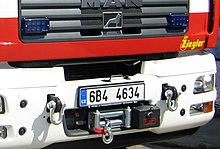Our website is made possible by displaying online advertisements to our visitors.
Please consider supporting us by disabling your ad blocker.
Winch
This article needs additional citations for verification. (November 2023) |


A winch is a mechanical device that is used to pull in (wind up) or let out (wind out) or otherwise adjust the tension of a rope or wire rope (also called "cable" or "wire cable").
In its simplest form, it consists of a spool (or drum) attached to a hand crank. Traditionally, winches on ships accumulated wire or rope on the drum; those that do not accumulate, and instead pass on the wire/rope (see yacht photo above), are called capstans. Despite this, sailboat capstans are most often referred to as winches. Winches are the basis of such machines as tow trucks, steam shovels and elevators. More complex designs have gear assemblies and can be powered by electric, hydraulic, pneumatic or internal combustion drives. It might include a solenoid brake and/or a mechanical brake or ratchet and pawl which prevents it unwinding unless the pawl is retracted. The rope may be stored on the winch. When trimming a line on a sailboat, the crew member turns the winch handle with one hand, while tailing (pulling on the loose tail end) with the other to maintain tension on the turns. Some winches have a "stripper" or cleat to maintain tension. These are known as "self-tailing" winches.[1]
- ^ Mark Smith. The Annapolis Book of Seamanship. 1999 Simon & Schuster
Previous Page Next Page


